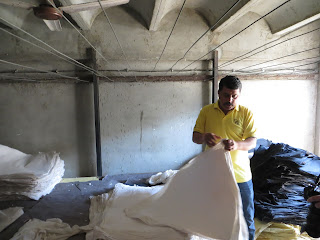Paper making in India! You have probably at some point in your life purchased some nice paper or decorated boxes for presidents or formal letters of some kind and you might have noticed a "Made in India" label but never really thought about the process that might have gone into making those products. I can show you one example of how this is done.
Here you will see some of the end products of this facility. The British actually destroyed most industry when they controlled most of South Asia from 1830 through 1947. You see, the purpose of colonization was for the dominating country to extract resources and to do that you wouldn't want the locals using their resources to make their own products. There was already quite a bit of industry here, primarily in textiles but there were all sorts of industries as the industrial revolution didn't just happen in Europe and America back in the 1700s, the knowledge of industrial processes spread all over.
In fact, by 1750, South Asia was making 12 to 14 times more cotton cloth than not only Britain but all of Europe combined. For Britain to really rake in the cash, they had to destroy any competition for their own clothing industry so they specifically punished colonies who produced their own. That way, not only was there competition, but the people of those colonies would have nowhere else to go for their cloth and other industrial products than Britain so they cornered the market through force."While the Mills of Yorkshire prospered, the bones of Bengali weavers bleached the plains of India"- Lord Bentinck (Pulsiper, 335)
This process created a huge surplus of labor, and mechanization in agriculture also erased many jobs and thus huge numbers of poor and landless people migrated to major cities looking for work. Many went into debt and became indentured servants, enslaved to their debtors. On the plus side, the "Green Revolution" of new agricultural crops and processes did lower the cost of food. Some of these were unsustainable, overused soils and more recently there has been a shift to "agroecology" which is using traditional non-chemical crop fertilizers and natural predators to control pests.
You will notice these huge bags of cloth in some of the pictures. They are making paper products here, but they are recycled from cloth of various kinds. They put the cotton cloth into large vats of water and sometimes chemicals to break it down into fibers. I visited a similar facility in Egypt where the cotton cloth was donated and the situation is similar here where this establishment is partially run with donations to help aid the group of woman who are running things. The guy in the yellow shirt is our guide but does not work there.
India has been making leaps and bounds lately when it comes to economic development, after independence from Britian they were able to re-industrialize with a big emphasis on self sufficiency rather than being stuck importing all their manufactured goods from other more developed nations. They originally put in a bunch of tariffs and taxes on imports, but by the 90's they decided to loosen many of these, primarily in the hopes of exporting their goods like the paper products they make here.
Globalization really surged at this point and the growth and spread of the internet has allowed many companies to outsource or relocate to this and many other nations of the world.
I don't want to give you the idea that debt is always a bad thing, there has been a huge amount of growth in microcredit. The Grameen Bank in Bangladesh started giving out very small loans throughout developing nations specifically to help poor people start up their own small businesses. Usually these loans are under a $100 bucks, and loans of only $20 is often enough to for example, purchase some chickens and start an egg business or a group can come together to use a sewing machine in shifts. The majority of these loans are in fact given to groups, often of women only and they as a group are responsible for repaying the loan. Repayment rates are over 98% (Pulsipher, 342)
Just gonna step in here to point out this form of air conditioning that you might not see so much in the U.S. though I have seen it in the southwest. This is a cooler, and no not a place to store soda pop but instead you have water trickling on this straw and there is a fan inside and this process is a cheap way to cool a place off without chemicals or the more expensive things needed for an air conditioner.
These are some religious posters, I would often see these when I was in India. People do little prayers in front of them from time to time. Below you will also see machinery where the cotton fibers that have been taken from the cloth are squished with the hand crank until it is paper. I think I will let the rest of the photos speak for themselves.


































































No comments:
Post a Comment